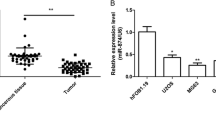Abstract
MicroRNAs are short regulatory RNAs that play crucial roles in cancer development and progression. MicroRNA-646 (miR-646) is downregulated in many human cancers, and increasing evidence indicates that it functions as a tumor suppressor. However, the role of miR-646 in osteosarcoma remains unclear. Expression levels of miR-646 in osteosarcoma cell lines and patient tissues were evaluated by quantitative real-time PCR (qRT-PCR), and the clinicopathological significance of the resultant data was later analyzed. Next, we investigated the role of miR-646 to determine its potential roles on osteosarcoma cell proliferation, migration, and invasion in vitro. A luciferase reporter assay was conducted to confirm the target gene of miR-646, and the results were validated in the osteosarcoma cell line. In this study, we found that miR-646 was downregulated in osteosarcoma cell lines and osteosarcoma tissues compared with normal osteoblast cell line NHOst and paired adjacent nontumor tissue. We found that a lower expression of miR-646 was associated with metastasis. In osteosarcoma cells, overexpression of miR-646 inhibited cell proliferation, migration, and invasion. In contrast, downregulation of miR-646 expression promoted osteosarcoma cell proliferation, migration, and invasion. Next, we identified that the FGF2 gene is a novel direct target of miR-646 in osteosarcoma cells. Moreover, enforced expression of FGF2 partially reversed the inhibition of cell proliferation, migration, and invasion that was caused by miR-646. Our study demonstrated that miR-646 might be a tumor suppressor in osteosarcoma via the regulation of FGF2, which provided a potential prognostic biomarker and therapeutic target.




Similar content being viewed by others
References
Ottaviani G, Jaffe N. The epidemiology of osteosarcoma[M]//pediatric and adolescent osteosarcoma. US: Springer; 2010. p. 3–13.
Mirabello L, Troisi RJ, Savage SA. Osteosarcoma incidence and survival rates from 1973 to 2004: data from the Surveillance, Epidemiology, and End Results Program. Cancer. 2009;115(7):1531–43.
Osaki M, Takeshita F, Sugimoto Y, et al. MicroRNA-143 regulates human osteosarcoma metastasis by regulating matrix metalloprotease-13 expression. Mol Ther. 2011;19(6):1123–30.
Yates LA, Norbury CJ, Gilbert RJC. The long and short of microRNA. Cell. 2013;153(3):516–9.
Iorio MV, Croce CM. MicroRNAs in cancer: small molecules with a huge impact. J Clin Oncol. 2009;27(34):5848–56.
Meng F, Henson R, Wehbe-Janek H, et al. MicroRNA-21 regulates expression of the PTEN tumor suppressor gene in human hepatocellular cancer. Gastroenterology. 2007;133(2):647–58.
Chow TF, Mankaruos M, Scorilas A, et al. The miR-17-92 cluster is over expressed in and has an oncogenic effect on renal cell carcinoma. J Urol. 2010;183(2):743–51.
Farazi TA, Hoell JI, Morozov P, et al. MicroRNAs in human cancer[M]//microRNA cancer regulation. Netherlands: Springer; 2013. p. 1–20.
Zhou Y, Huang Z, Wu S, et al. miR-33a is up-regulated in chemoresistant osteosarcoma and promotes osteosarcoma cell resistance to cisplatin by down-regulating TWIST. J Exp Clin Cancer Res: CR. 2014;33(1):12.
Huang J, Gao K, Lin J, et al. MicroRNA-100 inhibits osteosarcoma cell proliferation by targeting Cyr61. Tumor Biol. 2014;35(2):1095–100.
Zhao G, Cai C, Yang T, et al. MicroRNA-221 induces cell survival and cisplatin resistance through PI3K/Akt pathway in human osteosarcoma. PLoS One. 2013;8(1):e53906.
Finnerty JR, Wang WX, Hébert SS, et al. The miR-15/107 group of microRNA genes: evolutionary biology, cellular functions, and roles in human diseases. J Mol Biol. 2010;402(3):491–509.
Wang WT, Zhao YN, Yan JX, et al. Differentially expressed microRNAs in the serum of cervical squamous cell carcinoma patients before and after surgery. J Hematol Oncol. 2014;7(1):6.
Li W, Liu M, Feng Y, et al. Downregulated miR-646 in clear cell renal carcinoma correlated with tumour metastasis by targeting the nin one binding protein (NOB1). Br J Cancer, 2014.
Zhang H, Zhang Y, Duan HO, et al. TIP30 is associated with progression and metastasis of prostate cancer. Int J Cancer. 2008;123(4):810–6.
Paterson EL, Kazenwadel J, Bert AG, et al. Down-regulation of the miRNA-200 family at the invasive front of colorectal cancers with degraded basement membrane indicates EMT is involved in cancer progression. Neoplasia. 2013;15(2):180–IN22.
Qi L, Bart J, Tan LP, et al. Expression of miR-21 and its targets (PTEN, PDCD4, TM1) in flat epithelial atypia of the breast in relation to ductal carcinoma in situ and invasive carcinoma. BMC Cancer. 2009;9(1):163.
Ma L, Young J, Prabhala H, et al. miR-9, a MYC/MYCN-activated microRNA, regulates E-cadherin and cancer metastasis. Nat Cell Biol. 2010;12(3):247–56.
Cronauer MV, Schulz WA, Seifert HH, et al. Fibroblast growth factors and their receptors in urological cancers: basic research and clinical implications. Eur Urol. 2003;43(3):309–19.
Turner N, Grose R. Fibroblast growth factor signalling: from development to cancer. Nat Rev Cancer. 2010;10(2):116–29.
Kuhn H, Köpff C, Konrad J, et al. Influence of basic fibroblast growth factor on the proliferation of non-small cell lung cancer cell lines. Lung Cancer. 2004;44(2):167–74.
Giri D, Ropiquet F, Ittmann M. Alterations in expression of basic fibroblast growth factor (FGF) 2 and its receptor FGFR-1 in human prostate cancer. Clin Cancer Res. 1999;5(5):1063–71.
Polnaszek N, Kwabi-Addo B, Peterson LE, et al. Fibroblast growth factor 2 promotes tumor progression in an autochthonous mouse model of prostate cancer. Cancer Res. 2003;63(18):5754–60.
Li D, Wei X, Xie K, et al. A novel decoy receptor fusion protein for FGF-2 potently inhibits tumour growth. Br J Cancer, 2014.
Zhou B, Ma R, Si W, et al. MicroRNA-503 targets FGF2 and VEGFA and inhibits tumor angiogenesis and growth. Cancer Lett. 2013;333(2):159–69.
Ren T, Qing Y, Dai N, et al. Apurinic/apyrimidinic endonuclease 1 induced upregulation of fibroblast growth factor 2 and its receptor 3 induces angiogenesis in human osteosarcoma cells. Cancer Sci. 2014;105(2):186–94.
Conflicts of interest
None
Author information
Authors and Affiliations
Corresponding author
Rights and permissions
About this article
Cite this article
Sun, Xh., Geng, Xl., Zhang, J. et al. miRNA-646 suppresses osteosarcoma cell metastasis by downregulating fibroblast growth factor 2 (FGF2). Tumor Biol. 36, 2127–2134 (2015). https://doi.org/10.1007/s13277-014-2822-z
Received:
Accepted:
Published:
Issue Date:
DOI: https://doi.org/10.1007/s13277-014-2822-z




